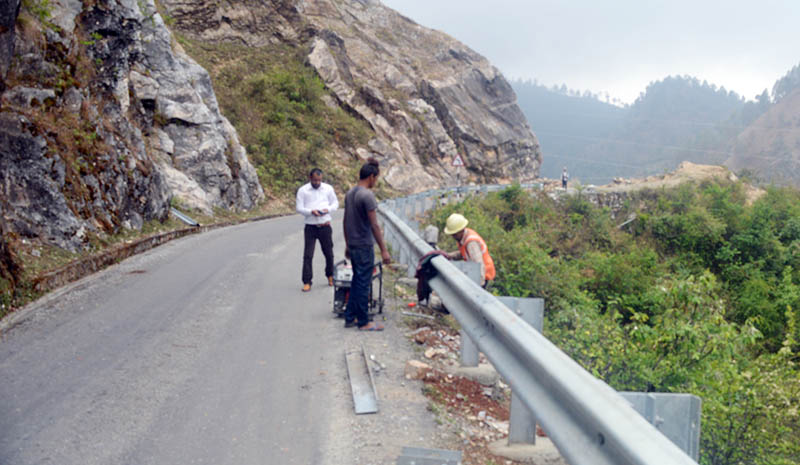Nepal needs additional $879m for safer roads: WB
Kathmandu, February 21
As vehicle ownership grows in Nepal, road crashes will continue to steadily climb
Nepal needs to invest an estimated extra $879 million in road safety over the next decade to halve its road crash fatalities, says a new World Bank report.
In Nepal, road crash deaths and injuries have been on a sharp upward trajectory since early 2000s with a fatality rate of 8.59 per 100,000 in fiscal 2017-18, as per official reports. In the same period, 4,144 serious injury and several minor injury victims were also officially reported.
However, as per World Health Organisation data, estimated fatality rate in 2016 was 15.9 per 100,000 population, which is nearly double official estimate.
Released at the Third Global Ministerial Conference on Road Safety in Stockholm on Thursday, the report ‘Road Safety in South Asia: Opportunities for Shared Regional Initiatives’ points to the high death rate on the roads in the eastern subregion — which comprises Bhutan, Bangladesh, India, and Nepal — caused by chronic lack of investment in systemic, targeted, and sustained road safety programmes and identifies relevant investment priorities to reverse the trend.
A separate country-specific World Bank report titled ‘Delivering Road Safety in Nepal’ has pointed out that improving road safety in the country is vital to national health, well-being, and economic growth. While Nepal has a National Road Safety Strategy and Road Safety Action Plan based on the five pillars of United Nations Global Plan for the Decade of Action for Road Safety 2011-20, ‘only limited progress has been made on addressing these pillars and consequently Nepal is facing serious road safety challenges’, the World Bank report on Nepal’s road safety says.
A recent World Bank Group (WBG) study of road safety investment in South Asia revealed a crisis that has been exacerbated by the rapid growth in vehicle ownership and diversity of motorised and non-motorised traffic of varying sizes and speeds, without adequate protection for the most vulnerable. “It is clear that as vehicle ownership grows in Nepal, road crashes will continue to steadily climb — unless urgently required measures are implemented.”
The World Bank report has said that sharply reducing the number of crash fatalities and injuries over time would enable countries like Nepal to achieve substantial increases in economic growth and national income, while simultaneously achieving large population welfare gains.
“However, governance challenges impede the mobilisation of a systemic, targeted, and sustained road safety programme in Nepal. Agencies responsible for road safety are inadequately empowered and resourced.”
Poor road safety performance in Nepal is a symptom of underinvestment in targeted initiatives, World Bank has said estimating country will require an additional investment of $879 million over coming decade, if it is to achieve Sustainable Development Goal 3.6 target of a 50 per cent reduction in national road crash fatalities. “It will take long-term commitment and sustained vision from the Nepal government for this investment to be effective and bring road safety performance under control on a sustainable basis.”
Stating that the World Bank research indicates that human capital accounts for around two-thirds of a country’s total wealth, the report has said investment in effective road crash fatality and injury prevention will contribute to the accumulation of human capital in Nepal, which in turn will contribute to sustainable and inclusive economic growth and overall country wealth.
Meanwhile, the South Asia report has called for regional initiatives to make roads and vehicles safer. It has emphasised the need to focus on regional trade corridors where crashes are significant, and roads are unsafe.
“The road safety conditions on these regional corridors mirror the nature and scale of conditions prevalent on national highways.
Crash data collected in a sample of highway sections across Nepal, India, and Bangladesh reveal alarming annual fatality rates ranging from 0.3 to three fatalities per kilometre, at a yearly average of 0.87 fatalities per kilometre.”
To better monitor the effectiveness of road safety efforts, the report has recommended a shared regional initiative to harmonise crash data management and analysis systems across South Asia. Currently, South Asian countries are in varying stages of developing crash data and performance management systems that analyse the underlying factors behind each crash — whether it was defective road infrastructure, faulty vehicle design or human error.
To complement these efforts and to facilitate more rapid and effective knowledge transfer, the report has suggested South Asian countries could join the proposed regional road safety observatory for Asia and the Pacific.






